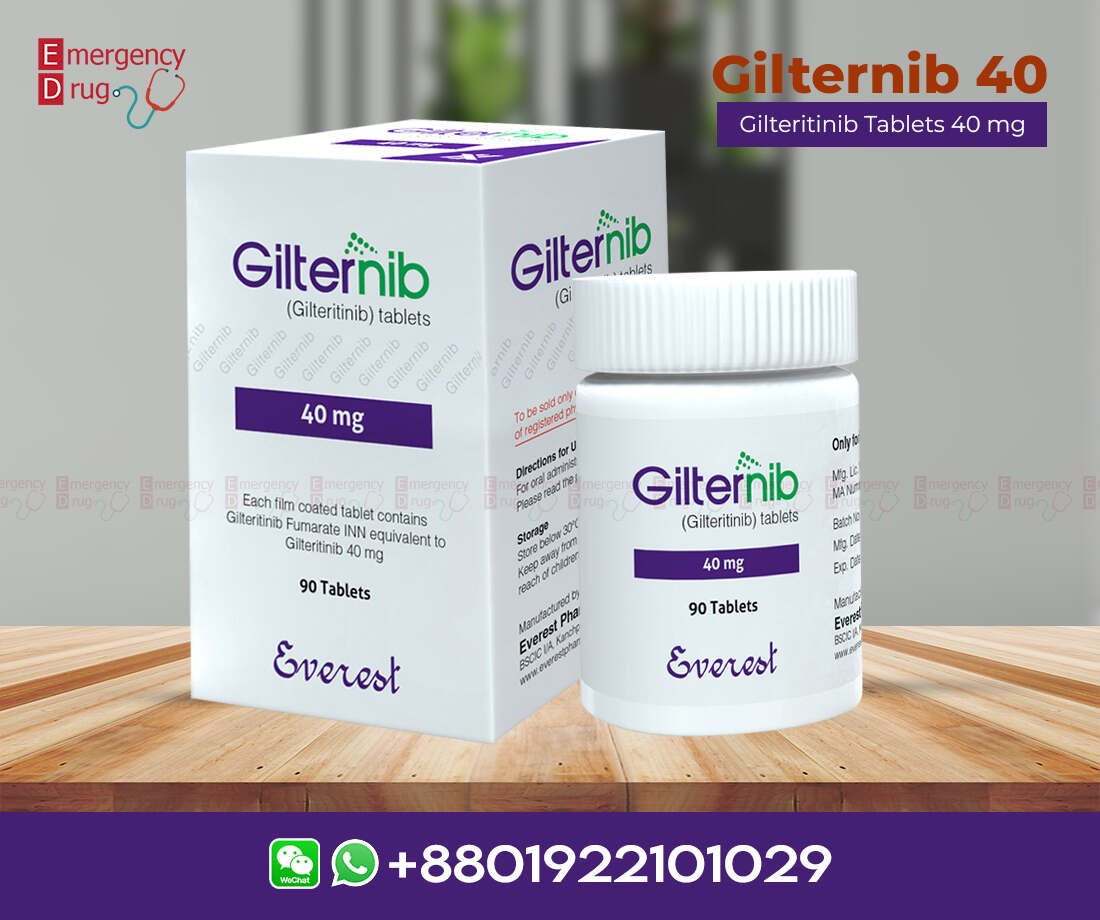Description
Gilternib tablet: Each film coated tablet contains Gilteritinib Fumarate INN equivalent to Gilteritinib 40 mg.
Product Features
| Product Name | : | Gilternib |
| Generic Name | : | Gilteritinib |
| Formulation | : | Tablet |
| Available Pack Size | : | 90’s Pot |
| Available Strength | : | 40 mg |
| Registrations | : | Export Only |
Gilteritinib fda approval: Gilteritinib was approved by the U.S. Food and Drug Administration (FDA) in 2018 for the treatment of relapsed or refractory FLT3-mutated AML in adult patients.
Gilteritinib Mechanism of Action
Gilteritinib is a tiny molecule that blocks several proteins called receptor tyrosine kinases, including one called FMS-like tyrosine kinase 3 (FLT3). By doing this, it stops FLT3 from sending signals and causing cells to grow in people with certain types of leukemia.
Studies have shown that gilteritinib can stop FLT3 from working and slow down the growth of cells that have FLT3 mutations, like FLT3-ITD, as well as mutations in the tyrosine kinase domain (TKD), such as FLT3-D835Y and FLT3-ITD-D835Y. It can also make leukemia cells with FLT3-ITD mutations die off.
Cardiac Electrophysiology
When patients took Gilteritinib 120 mg once a day, their QTc interval (a measure of heart rhythm) didn’t increase significantly on average. Out of 317 patients who had their QTc measured during treatment, only 4 (1.3%) had QTc intervals longer than 500 msec. Across all doses, 2.3% of patients with relapsed or refractory AML had QTc intervals over 500 msec.
Effect of Food
When healthy adults took a single dose of Gilteritinib 40 mg with a high-fat meal, the highest concentration of the drug (Cmax) decreased by 26%, and the total exposure to the drug (AUC) decreased by less than 10% compared to taking it on an empty stomach. The time it took for the drug to reach its highest concentration (tmax) was delayed by 2 hours with a high-fat meal.
Elimination & Absorption
Gilteritinib has an estimated half-life of 113 hours and an apparent clearance of 14.85 L/h. In the fasted state, the time it takes for Gilternib to reach its maximum concentration (tmax) is typically observed between 4 and 6 hours after dosing.
Gilteritinib Side Effects
Here are some potential side effects of the drug mentioned in the label:
- Fever
- Dizziness or feeling lightheaded
- Coughing
- Rapid weight gain
- Difficulty breathing
- Swelling in your arms or legs
- Skin rash
- Decreased urination
Dosage and Administration
Patient Selection: Doctors should consider treating AML patients with Gilteritinib if they have FLT3 mutations in their blood or bone marrow. Tests approved by the FDA can help detect these mutations.
Recommended Dosage: Start with 120 mg of Gilteritinib once daily by mouth, with or without food. It may take time to see a response. Doctors usually recommend at least 6 months of treatment unless there’s disease progression or severe side effects. Don’t break or crush the tablets. Take them around the same time every day. If you miss a dose, take it as soon as possible on the same day, but at least 12 hours before the next scheduled dose. Resume the normal schedule the next day. Avoid taking two doses within 12 hours.
Dose Modification: Doctors should check blood counts and chemistries, including creatine phosphokinase, before starting Gilternib and regularly during treatment. They should also do an electrocardiogram (ECG) before starting treatment, on days 8 and 15 of the first cycle, and before each subsequent cycle.
Use in Specific Populations
Pregnancy and Breastfeeding
- Gilteritinib may harm unborn babies based on animal studies. Pregnant women should be aware of this risk.
- There’s no data on Gilternib in breast milk. Because it could harm the baby, nursing mothers should avoid breastfeeding while taking it and for 2 months after stopping.
Females and Males of Reproductive Potential
- Women should have a pregnancy test before starting Gilternib.
- Both peoples should use effective contraception during treatment and for some time after the last dose.
Pediatric Use: Gilteritinib’s safety and effectiveness haven’t been studied in children.
Geriatric Use: About 43% of patients in studies were aged 65 or older, and 13% were 75 or older. There were no notable differences in how well the drug worked or its safety compared to younger patients.
Warnings and Precautions
Differentiation Syndrome
- 3% of patients treated with Gilteritinib experienced differentiation syndrome, which can be life-threatening if not treated promptly.
- Symptoms include fever, difficulty breathing, fluid buildup in the lungs or around the heart, rapid weight gain, skin rash, and kidney problems.
- Treatment involves using corticosteroids like dexamethasone and close monitoring of vital signs.
Posterior Reversible Encephalopathy Syndrome (PRES)
- 1% of patients experienced PRES, characterized by seizures and altered mental status.
- Diagnosis requires brain imaging, preferably MRI.
- Gilternib should be stopped in patients diagnosed with PRES.
Prolonged QT Interval
- Gilternib can lead to prolonged QT intervals in the heart.
- Regular ECG monitoring is necessary, especially at the start of treatment and during subsequent cycles.
- Dosage reduction or interruption may be necessary if QT interval exceeds certain thresholds.
Pancreatitis
- 4% of patients experienced pancreatitis while on Gilteritinib.
- Patients showing signs of pancreatitis should have their treatment interrupted and the dosage reduced.
Embryo-Fetal Toxicity
- Gilternib can harm unborn babies based on animal studies.
- Effective contraception is advised during treatment and for some time after the last dose, for both patients.
- Pregnant women or those planning pregnancy should be aware of potential risks to the fetus.
visit our other acute myeloid leukemia products
